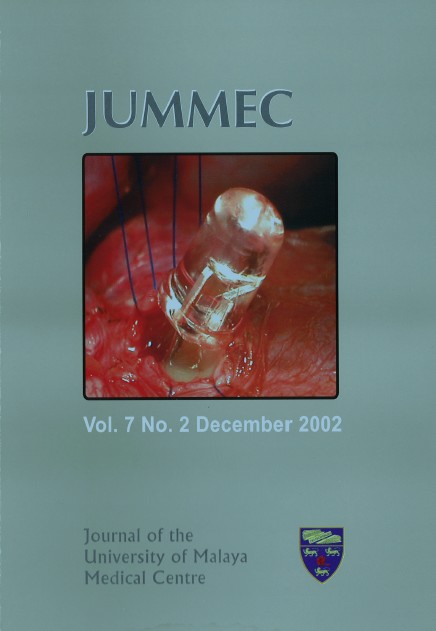Western Blot Analysis of Polyclonal Antibodies from Experimental Animals against Blastocystis Antigens
Abstract
One (1) anti-Blnslocystis serum from a monkey naturally infected with isolate
M12and four (4) hyperimmune sera raised in inbred Balb/c mice against crude antigens
of two B/astocystis isolates (e and KI~). one each of E/ltamoeba Ilistolytica (HK9) and
Giari/in Jall/blia (7404) were used to react with several homologous and heterologous
Blastocystis isolates, E.llistofytica, G. lambfia, EIU/olimax 1/(1/1(1 and Bac-4 (Escherid,ia
coli isolated from culture medium of a B. JIO",itlis isolate KPl). All anti.Blastocystis
sera did not showcross'reactivity with E. Mstolyticn and G.lnlllblin by western blotting.
Similarly, anti-E. Iristolyticn and anti-G. lnmblin sera also did not react against all
Blnstocystis isolates tested, even though these tmet' protozoa are known to produce
diarrhoea in humans. Polycional sera raised against antigen prepared from xenic culture
of Blastocystis produced a smear reaction on the immunoblot, while antibodies raised
against antigens prepared from axenic culture (isolate q gave prominent reaction bands.
This may be due to the purity of the immunogen used in inducing the immune response.
The cros~reactionsof sera from mice immunised with the xenic B. IlOlIIitris isolates
may also due to antibodies against E. coli. Anti-Blastocyst;s serum Crom monkey's
with natural infection showed several prominent reaction bands together with a smear
at above 40 kD were most probably induced by the excretory-sKretory antigens of the
parasite. A variety of reaction patterns were obtained with these anti'sera and the
antigens from different Blnstocystis isolates. These may be reClecis from differences
in antigenic components from various strains of this parasite.
Downloads
Downloads
Published
Issue
Section
License
All authors agree that the article, if editorially accepted for publication, shall be licensed under the Creative Commons Attribution License 4.0 to allow others to freely access, copy and use research provided the author is correctly attributed, unless otherwise stated. All articles are available online without charge or other barriers to access. However, anyone wishing to reproduce large quantities of an article (250+) should inform the publisher. Any opinion expressed in the articles are those of the authors and do not reflect that of the University of Malaya, 50603 Kuala Lumpur, Malaysia.


